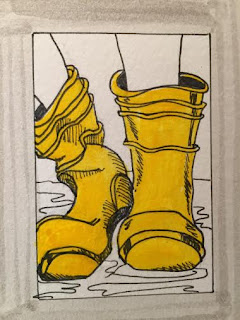When I worked in a graphic arts shop a million years ago, much of the work being done revolved around alignment of register marks, buttons and tabs to align multiple plates for four-color printing. The idea of mixing primary colors and dot patterns to create the entire color spectrum of color became intriguing to me from that point in time. The part of the process I did not fully realize until much later in my printing journey was the diverse properties of different inks.
Breaking down an image into it's color components adds a different aspect to the process of artistic production - one that is very mechanical and not necessarily creative - at least the way I think about creativity and the creative process. That is partially why I have decided to print all of my current prints in one color, and add color manually after the prints have dried. I was surprised to discover that there has not been a relief print ink designed specifically for this purpose since all of the inks I have investigated to this point in time remain water soluble long after the prints appear to be dry.
One way I have worked around this challenge, to some degree, is by using the printing ink closest to the dominant color I want to "flavor" the final image...well.....easier said than done. Since I enjoy complimentary colors in a single image, printing with a dominant color does not always allow me to have the contrast I desire in the final product.
The dandelion, first designed for a friend who loves to pull weeds, provided the opportunity to experiment with a couple of different printing colors.
 |
| Dandelion print - Black Speedball ink on tan Strathmore paper. |
I started with a proof print using black Speedball ink on tan Strathmore paper. I think the implied overlap of the images helps create dimension. Hand painting will allow me to add shading and highlights that printing in a 4-color separation style would not allow.
 |
| Dandelion print - Black Speedball relief ink, white China marker and 6B graphite pencil on Strathmore tan paper. |
Quickly adding some white China marker highlights and pencil (which appears as gray shading,) helps me see the dimensional aspect of the print. I have to remind myself that if I am going to be printing on these toned papers, such as the tan (Strathmore also has a gray,) that the color of the paper serves as a middle tone. Forcing myself to think about the role of the paper color is good practice for both printing AND working with pastels on toned paper!!! It might even carry over to the process I have needed in the past when working on a black canvas...well....similar. Obviously, the black canvas assumes the darkest element in the color pallet and NOT the middle tones.
I seldom think about the role a white canvas plays in the color pallet in the same way, and yet it is key in lights, darks and color selection!!!! Note to self: be deliberate about the role of the white canvas in color pallet choices and range of tones and shades from light to dark!
The addition of color to this print will be the next challenged, followed by printing in another color besides black.


















































